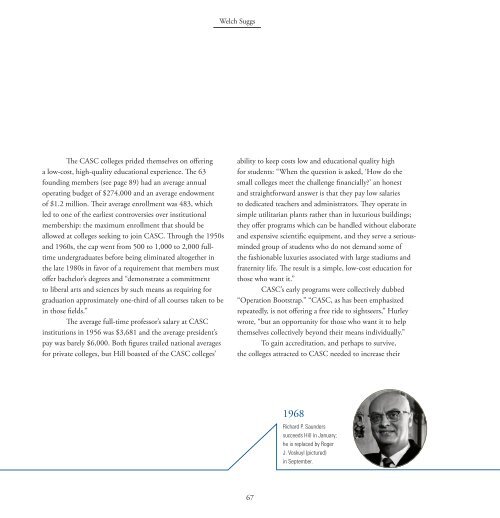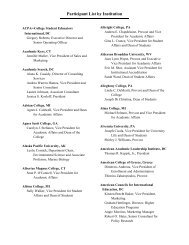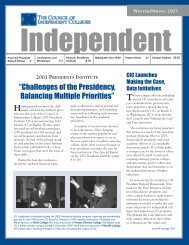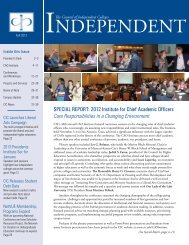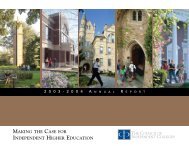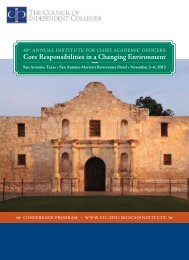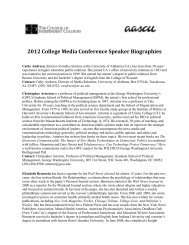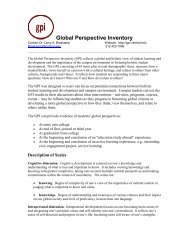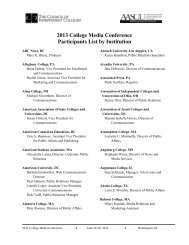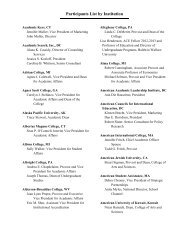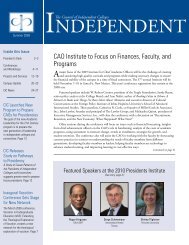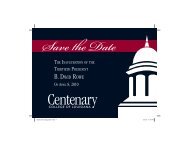Meeting the Challenge: - The Council of Independent Colleges
Meeting the Challenge: - The Council of Independent Colleges
Meeting the Challenge: - The Council of Independent Colleges
Create successful ePaper yourself
Turn your PDF publications into a flip-book with our unique Google optimized e-Paper software.
Welch Suggs<br />
<strong>The</strong> CASC colleges prided <strong>the</strong>mselves on <strong>of</strong>fering<br />
a low-cost, high-quality educational experience. <strong>The</strong> 63<br />
founding members (see page 89) had an average annual<br />
operating budget <strong>of</strong> $274,000 and an average endowment<br />
<strong>of</strong> $1.2 million. <strong>The</strong>ir average enrollment was 483, which<br />
led to one <strong>of</strong> <strong>the</strong> earliest controversies over institutional<br />
membership: <strong>the</strong> maximum enrollment that should be<br />
allowed at colleges seeking to join CASC. Through <strong>the</strong> 1950s<br />
and 1960s, <strong>the</strong> cap went from 500 to 1,000 to 2,000 fulltime<br />
undergraduates before being eliminated altoge<strong>the</strong>r in<br />
<strong>the</strong> late 1980s in favor <strong>of</strong> a requirement that members must<br />
<strong>of</strong>fer bachelor’s degrees and “demonstrate a commitment<br />
to liberal arts and sciences by such means as requiring for<br />
graduation approximately one-third <strong>of</strong> all courses taken to be<br />
in those fields.”<br />
<strong>The</strong> average full-time pr<strong>of</strong>essor’s salary at CASC<br />
institutions in 1956 was $3,681 and <strong>the</strong> average president’s<br />
pay was barely $6,000. Both figures trailed national averages<br />
for private colleges, but Hill boasted <strong>of</strong> <strong>the</strong> CASC colleges’<br />
ability to keep costs low and educational quality high<br />
for students: “When <strong>the</strong> question is asked, ‘How do <strong>the</strong><br />
small colleges meet <strong>the</strong> challenge financially’ an honest<br />
and straightforward answer is that <strong>the</strong>y pay low salaries<br />
to dedicated teachers and administrators. <strong>The</strong>y operate in<br />
simple utilitarian plants ra<strong>the</strong>r than in luxurious buildings;<br />
<strong>the</strong>y <strong>of</strong>fer programs which can be handled without elaborate<br />
and expensive scientific equipment, and <strong>the</strong>y serve a seriousminded<br />
group <strong>of</strong> students who do not demand some <strong>of</strong><br />
<strong>the</strong> fashionable luxuries associated with large stadiums and<br />
fraternity life. <strong>The</strong> result is a simple, low-cost education for<br />
those who want it.”<br />
CASC’s early programs were collectively dubbed<br />
“Operation Bootstrap.” “CASC, as has been emphasized<br />
repeatedly, is not <strong>of</strong>fering a free ride to sightseers,” Hurley<br />
wrote, “but an opportunity for those who want it to help<br />
<strong>the</strong>mselves collectively beyond <strong>the</strong>ir means individually.”<br />
To gain accreditation, and perhaps to survive,<br />
<strong>the</strong> colleges attracted to CASC needed to increase <strong>the</strong>ir<br />
1968<br />
Richard P. Saunders<br />
succeeds Hill in January;<br />
he is replaced by Roger<br />
J. Voskuyl (pictured)<br />
in September.<br />
67


